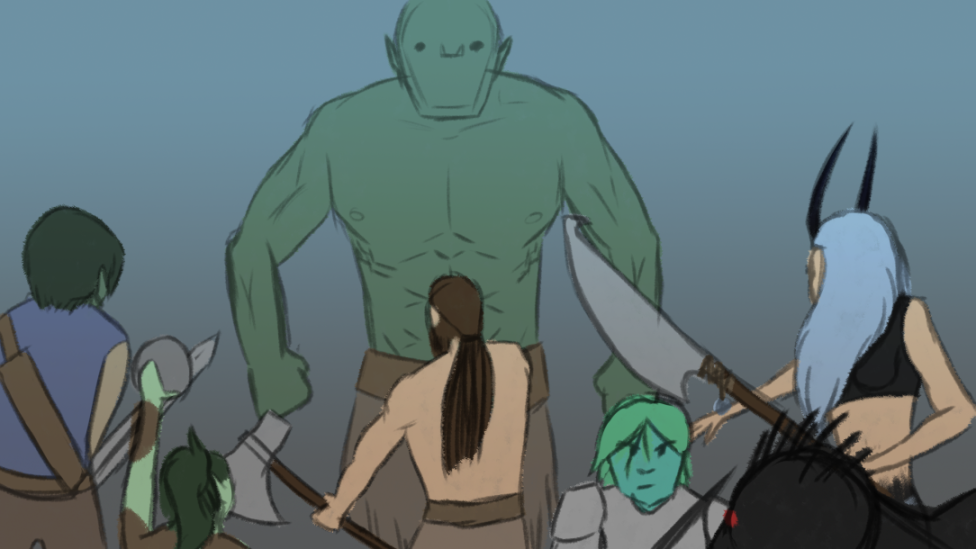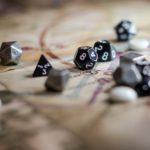Every Thursday night, me and four of my friends gather to play King’s Quest, with myself as the dungeon master. These nights are always a good time and because of that I decided to make a new segment as part of my weekly blog where I ‘ll be sharing stories, struggles, and points of interests that come up within my on-going campaign using the King’s Quest system.
Our first session we will be discussing is NOT the first session of the campaign, and if you are confused on what a session or a campaign is, then let me explain. A campaign is an overarching story, sometimes pre-made or homebrewed by your dungeon master (like I do), that has a main objective for players to complete or acheive. A better way to look at it is by comparing a campaign to a TV show’s overarching plot and sessions are like episodes within this TV show. A campaign can last as long as the dungeon master wants, whether that is a few months or a few years. A session on the other hand, can be anywhere between 4-12 hours long, I personally like to keep mine in the 5-6 hour range as I do not have time to write session notes for 12 hours, nor do I have the time to host sessions that long. If you are confused by any of this, feel free to leave a comment on this post and I will try to answer questions to the best of my ability.
This session took place on the 7th of October, 2021. I started the session off as I normally do. I give a brief summary of last session’s plot and mention the in-world date and time. This allows for players to get properly connected with the campaign and world. I also like to open with a flashback of one of the characters, not something I do every session but as often as I need too. During my flashbacks, there is minimal gameplay as the flashback itself is more used as a tool to encourage players to interact with each other during sessions. These, spoiler-free and highly vague, flashbacks are said out-loud to every player so curiosity often arises from players and they will be more likely to get in character and ask another character about their past. These do not need to go on forever and often only ever take 5-15 minutes of the session’s total run time. These can make for great fillers for someone who is running longer sessions.
Continuing on with discussing the session, our heroes start off at a tavern where they spend much of the beginning of the session. I pre-planned several activities and interactions to make the tavern feel lively and as intractable as possible. This was a lot of fun for my players as they had not yet been in a position to visit a tavern due to the character’s mostly being on the move. The players favorite activity was an unofficial arm-wrestling contest going on in the back corner of the tavern. One of the character’s Drusilla, who I would describe as a magical, witchy, business woman, came up with a risky plan that would allow the winner of the event to gain double the winnings. She did this by going around the tavern and asking patrons to donate to the prize pool. She then had the party’s strongest member, named Yhorm, participate in the competition. He was required to win a single arm-wrestling match against three other opponents in order to win the prize pool. Yhorm’s first opponent he completely crushed by rolling higher than his opponent. Against Yhorm’s second opponent, he failed, but after Yhorm gave himself advantage to Strength using his racial feature, he was also able to out-roll his second opponent. Yhorm’s final opponent was close to a tie, however, Yhorm was lucky once more and managed to also out roll the final opponent despite the opponent having a higher strength modifier than him. The party, thanks to this victory, gained enough money to upgrade their gear and to take on the next half of the session.
This second half of the session occurs when the party discovers a local dwarf’s coal mine had been infested with Draugrs due to the miners accidentally digging into cursed catacombs. Our heroes faced waves of low-level undead before stumbling across the catacombs the undead had been coming from. The group’s only magic user, Drusilla, spent several turns performing an exorcism to rid the catacombs of the corrupt magic that kept the undead walking. Meanwhile, the rest of the party defended her as waves of undead swarmed them. In the end they were able to succeed and rid the mine of the dangerous undead.
This is where the session ends, with Drusilla being voted MVP by the party due to her usefulness in driving out the corrupt magic in the catacombs, how Drusilla’s player interacted as her, and to allowing the party to win double the earnings in the arm-wrestling competition. I got the feeling by the end of the session that this one was definitely one of their favorites and I hope to continue to make future sessions of this quality and level of fun.
I hope that you, the viewer, learned something from this post. Next week will be a shorter post talking about some lore within King’s Quest. On Halloween week, I plan to post twice, talking a little about immersive sound and a little on King’s Quests’ canonic races.



 Posted by Jac Vonachen
Posted by Jac Vonachen


